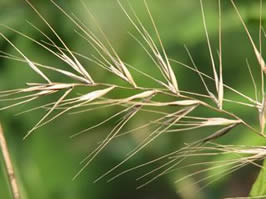Greetings!
Fall is here, and for gardeners it's time to start thinking of preparing for spring. In this edition, you'll find a variety of ways you can prepare for next year, and you can also learn how you can help scientists learn more about global warming.
Janet Allen,
President, Habitat Gardening in Central New York
|
|
October 25 program: Hands-on seed propagation
Our next meeting on Sunday, Oct. 25 at 2:00 pm will feature a hands-on presentation about how to collect, clean and prepare seeds to grow new plants.
Joan Livingston, owner of Growing Wild Perennials, 4080 E. Milestrip Rd. in Canastota returns to be our presenter. She presented this program in one of HGCNY's early years, and it was a very popular program.
 Bottlebrush grass (Elymus hystrix) grown from a plant started at Joan's first HGCNY presentation many years ago! Bottlebrush grass (Elymus hystrix) grown from a plant started at Joan's first HGCNY presentation many years ago!
Our HGCNY meetings are free and open to the public. We'll be meeting at our usual Le Moyne College Library location in the Special Activity Room. (See our website for directions.) Come and bring a friend!
|
|
"I thought I planted a ...."
"I wonder where I put that ..."
"What's that plant?"
If you're like most of us, after a long winter, you've forgotten what you planted and where you planted it. You're more likely to know where those plants are now, so NOW is the time to take good notes (and put them where you'll remember them come spring!)
Another strategy, of course, is to use plant markers--a good idea, but sometimes plant markers heave out of the ground or become unreadable. And if you have a large number of plants, it's hard to put markers on all of them.
An alternative is to take some digital photos, print them out in pale grayscale, then label the plants right on the photo. You'll have a visual guide to where the plants are.
If you still remember where they are, you could also note the plants that bloom in the spring, but which may not be as visible now. Next spring, you could supplement your fall photos with another set of photos taken in the spring, when it's mostly bare ground with just the beginnings of plants peeking through the soil.
With a little effort now, you won't have to wonder where or what your plants are in spring!
|